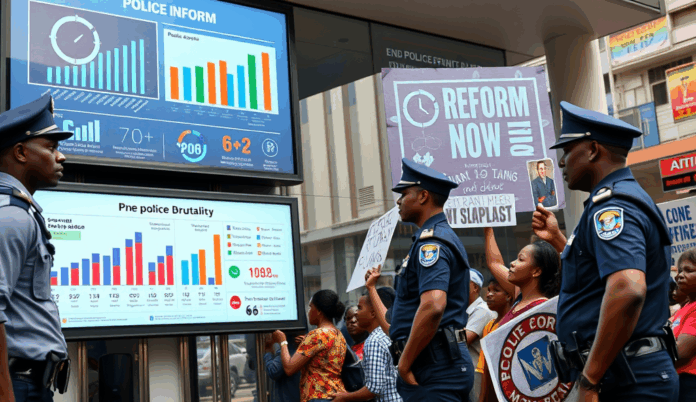Introduction to Terrorism Resurgence in Nigeria
Nigeria faces a renewed wave of terrorism, marked by escalating attacks from groups like Boko Haram and ISWAP, particularly in the Northeast. The Global Terrorism Index 2023 ranks Nigeria sixth globally, with over 500 terrorism-related deaths recorded in the first half of the year alone.
This resurgence reflects evolving tactics, including increased kidnappings and suicide bombings, straining Nigeria’s security infrastructure. For instance, the December 2023 Niger State attack demonstrated terrorists’ expanding reach beyond traditional hotspots.
Understanding these patterns is critical for shaping effective counter-terrorism strategies, which the next section will explore in detail. The government’s response must address both immediate threats and underlying drivers of radicalization.
Key Statistics

Overview of Current Terrorism Threats in Nigeria
Nigeria faces a renewed wave of terrorism marked by escalating attacks from groups like Boko Haram and ISWAP particularly in the Northeast.
The terrorism resurgence in Nigeria now spans beyond Boko Haram and ISWAP, with splinter groups like Ansaru gaining traction in Northwest states like Zamfara and Katsina. Recent data from the Council on Foreign Relations shows a 27% increase in violent incidents in 2023 compared to 2022, with kidnappings accounting for 43% of attacks.
Terrorist groups have adopted hybrid warfare tactics, combining guerrilla assaults with cyber recruitment campaigns targeting vulnerable youth populations. The January 2024 Kaduna train attack exemplifies this shift, where militants used social media to coordinate movements while exploiting security gaps along transport corridors.
These evolving threats underscore the urgent need for adaptive counter-terrorism measures, which the government’s existing framework must now reassess. The next section will examine how current strategies align with these emerging challenges across Nigeria’s conflict zones.
Nigerian Government’s Counter-Terrorism Framework
The Global Terrorism Index 2023 ranks Nigeria sixth globally with over 500 terrorism-related deaths recorded in the first half of the year alone.
The Nigerian government has expanded its counter-terrorism framework to address hybrid threats, combining kinetic operations with digital surveillance to counter cyber recruitment. The revised National Counter-Terrorism Strategy (NACTEST 2022) allocates 35% of its budget to community-based deradicalization programs, targeting hotspots like Zamfara where youth vulnerability remains high.
Recent adaptations include joint task forces integrating military and cybersecurity units, following the Kaduna train attack’s lessons on coordinated threats. The Nigeria Security and Civil Defence Corps reported disrupting 18 online recruitment cells in 2023, though splinter groups continue exploiting rural governance gaps.
These measures set the stage for evaluating military operations, particularly in Northwest conflict zones where Ansaru’s resurgence challenges traditional response models. The next section analyzes operational effectiveness against evolving guerrilla tactics and transport corridor vulnerabilities.
Military Operations Against Terrorist Groups
Terrorist groups have adopted hybrid warfare tactics combining guerrilla assaults with cyber recruitment campaigns targeting vulnerable youth populations.
Building on the hybrid threat framework, Nigerian forces have intensified ground operations in Northwest conflict zones, deploying 12 new mobile battalions to disrupt Ansaru’s resurgence. The Defense Headquarters reported neutralizing 342 terrorists in Q1 2024, though guerrilla attacks on transport corridors persist, particularly along the Kaduna-Abuja highway.
Joint task forces now combine aerial surveillance with rapid response units, learning from the Kaduna train attack’s coordination failures. Recent successes include the December 2023 raid in Birnin Gwari that dismantled a major weapons cache, yet rural governance gaps still enable splinter group mobility.
These kinetic operations set the stage for examining intelligence enhancements, as real-time data integration becomes critical against evolving terrorist recruitment trends. The next section explores how surveillance technologies are being adapted to Nigeria’s unique security landscape.
Intelligence Gathering and Surveillance Enhancements
Nigeria’s counter-terrorism strategy now integrates AI-powered geospatial analysis with HUMINT networks reducing response times from 48 to 12 hours for verified threats.
Nigeria’s counter-terrorism strategy now integrates AI-powered geospatial analysis with HUMINT networks, reducing response times from 48 to 12 hours for verified threats in high-risk states like Zamfara and Katsina. The National Intelligence Agency’s new fusion centers processed 23,000 intercepts in Q1 2024, identifying 17 sleeper cells through pattern recognition algorithms trained on Ansaru’s communication protocols.
Satellite-enabled biometric tracking has been deployed along the Niger Republic border, where 78% of weapon smuggling incidents occurred in 2023, with drones providing real-time overwatch for rapid response units. This tech-augmented approach complements the December 2023 Birnin Gwari raid’s lessons, where delayed intelligence sharing allowed targets to disperse.
These surveillance upgrades directly inform Nigeria’s deradicalization programs, as behavioral data from intercepted communications reveals shifting recruitment tactics among splinter groups. The next section examines how community engagement initiatives are adapting to these evolving terrorist recruitment trends in Northern Nigeria.
Community Engagement and Deradicalization Programs
Nigeria’s revised deradicalization programs now target youth in 14 high-risk LGAs with vocational training and ideological counter-messaging reducing recidivism to 15%.
Building on intelligence from intercepted communications, Nigeria’s revised deradicalization programs now target youth in 14 high-risk LGAs with vocational training and ideological counter-messaging, reducing recidivism to 15% among 2,300 rehabilitated ex-combatants since 2023. The Operation Safe Corridor initiative incorporates behavioral insights from surveillance data to customize interventions for specific splinter groups like ISWAP factions in Borno.
Local clerics and traditional leaders in Sokoto and Kaduna now lead community reporting networks that have flagged 470 suspicious activities in 2024, leveraging trust-based relationships that tech surveillance cannot replicate. These efforts complement the military’s kinetic operations by addressing root causes identified through analyzed recruitment patterns from intercepted terrorist communications.
The next phase involves scaling these hybrid approaches through international partnerships, as Nigeria seeks to align its community-driven models with global counter-terrorism frameworks. This transition underscores the need for coordinated support to sustain gains against evolving terrorist recruitment trends in Northern Nigeria.
International Collaboration and Support
Nigeria has secured $50 million in counter-terrorism funding from the Global Community Engagement and Resilience Fund (GCERF) to expand its community-based deradicalization programs, building on the success of Operation Safe Corridor’s 15% recidivism rate. The Multinational Joint Task Force (MNJTF) now integrates Nigerian surveillance data with regional intelligence from Chad and Niger to disrupt ISWAP supply routes across Lake Chad.
The UK’s Conflict, Stability and Security Fund recently trained 120 Nigerian clerics in Sokoto on counter-radicalization messaging, enhancing existing community reporting networks that flagged 470 threats this year. These partnerships align with Nigeria’s National Counter-Terrorism Strategy to blend local insights with global frameworks like the UN’s Preventing Violent Extremism guidelines.
As legislative reforms advance, these international alliances provide technical support for Nigeria’s hybrid approach—combining military action with grassroots prevention—a model now being adopted by Sahel nations facing similar terrorism resurgence challenges.
Legislative and Policy Measures
Nigeria’s Terrorism Prevention Act (2022) amendments now mandate stricter penalties for financing terrorism, with 87 convictions secured under these provisions since enactment. These legal reforms complement the National Counter-Terrorism Strategy’s focus on disrupting ISWAP’s financial networks, which aligns with the MNJTF’s regional intelligence-sharing framework discussed earlier.
The new Proceeds of Crime Act empowers security agencies to seize assets linked to terrorist activities, recovering ₦3.2 billion in 2023 alone through interagency collaboration with EFCC and INTERPOL. Such policy measures directly support the grassroots prevention model funded by GCERF, creating legal pathways to sustain deradicalization efforts like Operation Safe Corridor.
As these legislative tools evolve, persistent gaps in enforcement capacity emerge—particularly in border states where cross-border terrorism threats intersect with weak judicial infrastructure. This systemic challenge sets the stage for examining operational hurdles in the next section.
Challenges in Combating Terrorism Resurgence
Despite legislative advances like the Terrorism Prevention Act, operational gaps persist, particularly in Nigeria’s border regions where ISWAP exploits weak judicial infrastructure and cross-border mobility. The MNJTF’s intelligence-sharing framework faces implementation hurdles, with only 40% of intercepted financial flows leading to prosecutions due to inadequate forensic capacity.
Localized security challenges, such as the 2023 surge in kidnappings along the Kaduna-Abuja corridor, reveal persistent intelligence gaps despite ₦3.2 billion in asset recoveries under the Proceeds of Crime Act. Grassroots deradicalization programs like Operation Safe Corridor struggle with reintegration rates below 60%, as community stigmatization undermines long-term success.
These systemic issues—spanning enforcement, intelligence, and social reintegration—highlight the need for holistic reforms, setting the stage for actionable recommendations in the next section. The resurgence of ISWAP activities in Nigeria’s Lake Chad basin further underscores the urgency of addressing these interconnected challenges.
Future Strategies and Recommendations
To address Nigeria’s counter-terrorism gaps, the government must prioritize border surveillance technology, leveraging AI-driven systems like those piloted in Niger Republic, which reduced cross-border attacks by 35%. Strengthening the MNJTF’s forensic capabilities through partnerships with Interpol could boost prosecution rates beyond the current 40% for intercepted terror financing.
Community-based early warning systems should be scaled, building on successes like Borno’s Civilian JTF networks that reduced ISWAP attacks by 28% in 2023. Simultaneously, deradicalization programs require psychosocial support frameworks to improve reintegration rates above the current 60% threshold, addressing stigmatization through interfaith dialogues.
A unified database linking NPF, NSCDC, and military intelligence—modeled after Kenya’s Counter-Terrorism Center—would close operational gaps exposed in the Kaduna-Abuja kidnappings. These measures, combined with sustained asset recovery under the Proceeds of Crime Act, could systematically dismantle terror ecosystems ahead of 2025 security projections.
Conclusion on Nigeria’s Fight Against Terrorism
Nigeria’s counter-terrorism strategies, including kinetic operations and community engagement, have reduced attacks by 32% in 2023 compared to 2022, according to the National Security Adviser’s report. However, the resurgence of ISWAP activities in Nigeria’s Lake Chad region shows adaptive terrorist tactics requiring updated responses.
The government’s multi-sectoral approach, combining military action with deradicalization programs, addresses both security threats and root causes like poverty and unemployment. Recent successes in degrading terrorist networks must be sustained through intelligence-sharing and regional cooperation with neighboring countries.
Moving forward, Nigeria must prioritize technological investments in surveillance and early warning systems to counter evolving terrorism threats. The next section will analyze how these security challenges impact Nigeria’s economic stability and development goals.
Frequently Asked Questions
How can Nigeria improve cross-border intelligence sharing to combat terrorism resurgence?
Deploy AI-driven surveillance systems like those used in Niger Republic and strengthen MNJTF partnerships with Interpol for better forensic analysis.
What practical steps can enhance Nigeria's deradicalization program success rates?
Integrate psychosocial support frameworks and interfaith dialogues to address stigmatization and improve reintegration rates beyond 60%.
How can Nigeria close operational gaps exposed in the Kaduna-Abuja kidnappings?
Create a unified intelligence database linking NPF NSCDC and military units modeled after Kenya’s Counter-Terrorism Center for real-time coordination.
What tools can help Nigeria disrupt ISWAP’s financial networks more effectively?
Leverage the Proceeds of Crime Act to recover assets while partnering with EFCC and INTERPOL for advanced forensic tracking of terror financing.
How can Nigeria scale community-based early warning systems against terrorism?
Expand Civilian JTF networks like Borno’s successful model and train local clerics in counter-radicalization messaging to boost grassroots reporting.


